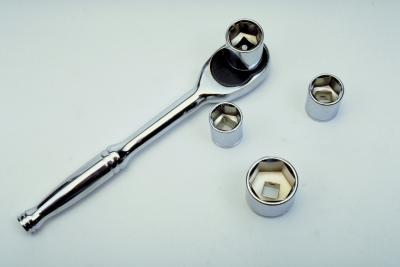
The vehicle speed sensor on your Taurus constantly communicates with the power train control module to let it know the various rates of speed at which the car travels. The information that the vehicle speed sensor collects also helps determine which gear the transmission should use as well as when the transmission should shift. As the sensor ages, it inevitably starts to send incorrect information. You may notice problems with the speedometer or extended times before the transmission shifts on automatic Taurus models. Luckily, replacing the vehicle speed sensor on your 1997 Taurus can be done at home in 30 minutes or less.
Open the driver’s door on your Taurus. Apply the emergency brake, then pull the hood release lever.
Raise the hood and locate the negative cable connected to the battery. The negative cable on the battery will have a "-" symbol next to it on the battery case.
Remove the negative battery cable from its post with a socket wrench. Wrap black electrical tape around the terminal on the cable before you set it down. Make sure the terminal on the cable isn’t anywhere near its post on the battery or any other metal, especially the engine.
Raise the front end of the Taurus with the hydraulic jack. Both front tires should be at least six inches from the ground.
Lift the support arms on both of the jack stands three inches. Lock the support arms on both jack stands at that height.
Place one jack stand on the passenger side of the car under the frame rail, which is located just behind the tire. Repeat this process on the driver’s side of the car with the second jack stand.
Slowly lower the hydraulic jack until your Taurus rests completely on both of the jack stands. Slightly rock the car back and forth to ensure that it is stable.
Place the third jack stand just under the front end of the car so that it’s accessible. Slide under the car head-first.
Position the third jack stand beneath the catalytic converter’s Y-pipe. Don’t raise the support arm on the jack stand. To locate the Y-pipe, follow the exhaust pipe from the rear of the car toward the front. Just before you get to the engine, the pipe will divide into two. This is the catalytic converter's Y-pipe.
Remove the nuts holding the catalytic converter’s Y-pipe to the exhaust manifold with a socket wrench. Lower the Y-pipe down onto the support arm of the jack stand. The exhaust manifold looks like two metal tubes that have been welded together. The engine uses the exhaust manifold to evacuate exhaust created during combustion.
Locate the vehicle speed sensor on the passenger side of the transaxle. It will have a wiring harness plugged into it as well as a single bolt holding it in place. The vehicle speed sensor may be covered by a small heat protection shield also, depending on the model of your engine. If so, remove the two bolts that hold the cover in place with a socket wrench.
Unplug the wiring harness from the vehicle speed sensor by hand. Do not use any tools to avoid damaging the plug or its wires.
Remove the bolt securing the vehicle speed sensor in place on the transaxle with a socket wrench. Withdraw the sensor outward from its mounting position.
Install your new vehicle speed sensor by reversing the removal steps. Tighten the sensor’s mounting bolt to 45 inch-lbs. with a 1/4-inch drive torque wrench. Tighten the mounting nuts for the catalytic converter’s Y-pipe to 30 ft-lbs. with a 3/8-inch drive torque wrench.
Remove the jack stand from under the Y-pipe. Raise the car again with the hydraulic jack. Remove both jack stands from the driver and passenger-side frame rail, then lower the car safely to the ground.
Remove the tape on the negative battery cable’s terminal. Connect the cable back to the battery and tighten the cable’s terminal nut with a socket wrench until secured. Shut the hood and release the emergency brake. Start the engine on your Taurus and take the car for a test drive to check the repair.